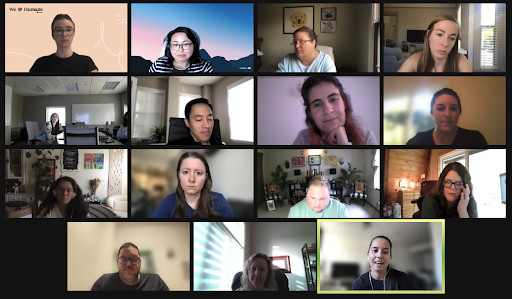At the start of COVID-19 pandemic, organizations rushed to set up emergency remote and hybrid work arrangements. Now, over two years later, it’s clear that these flexible work arrangements are here to stay. According to a new survey from Gallup, 32% of respondents said their preferred work situation was fully remote, while 59% said they would rather work in a hybrid environment. And only 9% said they wanted to work solely in the office. This shift making hybrid workplaces more commonplace should be prompting organizations to rework every aspect of their operations to adjust to these changes, according to Lattice's new eBook Driving Engagement and Retention in the Hybrid Workplace.
This adjustment requires that companies take a hard look at their hybrid hiring and onboarding processes, said Jennifer Durbin Tuffy, founder of Raleigh, NC-based executive coaching practice Scoutenger. “There are so many differences and so many more decisions that have to be made in a hybrid environment than [in] the old way that we used to hire people,” she said.
Getting hiring and onboarding right may matter now more than ever, as workers are leaving their jobs in record numbers amid the Great Resignation. According to Gallup, the cost of a bad hire can amount to as much as two times the employee’s annual salary. And research from Brandon Hall Group found that organizations with a strong onboarding process boost their new-hire retention by 82% and productivity by more than 70%.
In order to stay competitive and relevant, companies must adjust their hiring and onboarding process to address all the upheaval, said Marisa Bryan, Global Vice President of Talent at digital analytics startup Contentsquare. Hybrid models, after all, are the future of work. “We’re all having to find ways to make this work because it’s not going back the way it was,” Bryan said.
To find the right talent and then ensure that these individuals are set up to succeed and remain engaged and motivated on the job, it’s crucial that hiring and onboarding be reworked to reflect the changing needs of today’s companies and employees. Here are three best practices for hiring and onboarding in a hybrid world.
3 Best Practices for Hybrid Hiring and Onboarding
1. Get your policies in order.
Hiring for a hybrid workforce is very different from hiring employees who only work in-office. No longer is everybody clocking in and out at the same time from the same location. Now, there could be as many work scenarios as there are employees. Before hiring for hybrid roles, organizations must ensure that the policies and expectations for how and when hybrid employees work are established, clear, and equitable so new hires don’t have any unwelcome surprises when they start their new roles.
“At the end of the day, [a] candidate is going to make a decision [about] whether [a] job is right for them or not based on their experience working for that company,” said Jessica Donahue, founder and consultant at HR consulting firm Adjunct Leadership Consulting. “And if their experience working for that company is that they feel like they were the victim of a bait-and-switch, where they were told one thing and then experienced something else that’s not in line with what they expected, they’re going to leave.”
Organizations can’t anticipate every possible scenario, said Tuffy, and no matter how much you prepare, surprises will inevitably crop up. But it’s essential to thoroughly consider what policies your company will need to have in place when hiring and onboarding a hybrid workforce, and then clearly articulate those policies to HR, hiring managers, and job candidates alike. Policies might address the following questions and topics, among others.
Who can be remote employees or work on a hybrid team?
- Are there exceptions to the hybrid rules?
- Do new hires or entry-level workers need to report to the office for a period of time to help them absorb the company culture or for development purposes, for example?
Could the organization require a fully in-office workforce at some point?
- If so, are there particular metrics, such as COVID transmission rates or company needs, that might prompt that shift?
- If there’s a switch to requiring onsite work in the future, would the company cover relocation costs for out-of-town workers?
What is the work schedule? Are hybrid roles asynchronous, or will employees need to be available during traditional work hours?
- Do traditional work hours for each individual take place in the time zone where the company headquarters is based, or where each employee is located?
What are the in-office requirements for workers?
- Are masks or COVID vaccines required?
- Will employees need to reserve workspaces or parking in advance?
- How often are employees required to go into the office, and for what reasons (an all-hands meeting or client presentations, for example)?
What workplace benefits will be extended to hybrid employees?
- Will the company offer stipends for home office equipment and supplies, like ergonomic chairs, printers and printer ink, or notebooks and pens, for example?
Once the policies are established, it’s important to include these details in job descriptions so prospective candidates can determine if a role is right for them.
2. Be intentional about the interview process.
Just as the workforce has shifted, so have the traits that employees need to possess. To be successful, hybrid and remote workers must be adaptable and resilient, self-motivated, good communicators, and collaborative, according to an article on Society for Human Resource Management (SHRM)’s website. During the interview process, asking open-ended questions, like these sample questions compiled by Indeed.com, can help uncover and assess candidates’ aforementioned soft skills.
At Contentsquare, employees who are not evaluating a job candidate’s technical skills or making a hiring decision are assigned to ask prospects these kinds of questions, Bryan shared. These team members are often potential peers or employees who work in different parts of the organization.
“[This] also drives our vision around diversity and making sure that we’re bringing in different perspectives and bringing in people from different parts of the business to provide input and insight to candidates,” said Bryan.
For virtual interviews, organizations also need to think about how the actual interview takes place. Here are two expert tips for conducting a successful virtual interview process:
- Provide an interview escort. With in-person interviewing, typically a job candidate is assigned to someone who will guide them through the day but has no other role in the hiring process. This is essential for virtual interviews, too, Bryan said. Give candidates a guide who will make sure they have time for a coffee or restroom break during the day, for instance, and who can serve as their go-to liaison throughout the entire interview process.
- Minimize bias. Be mindful that if you’re interviewing people online and face-to-face for the same role, your bias may point you toward the individual you met in person, Bryan cautioned. “The person you had the cup of coffee with and talked with about the football game last night, you’re going to have a much better personal contact and personal feeling with them than the person you looked at on a flat screen,” she said.
Even if the candidate is local, Bryan recommended conducting all interviews virtually to ensure that every candidate is assessed in the same way. Organizations might only bring in the finalists for an in-person meetup, she said.
3. Tailor your onboarding practices to a hybrid workforce and keep new hires informed.
The period from job acceptance to first day is a critical one for new hires — and it can be even more tricky in a hybrid work environment where employees need to be onboarded to both in-person and virtual work needs.
To ease the transition, communication is key, said Donahue — and it should begin long before a new employee’s first day on the job. In advance of their first day, Donahue likes to give new hires a schedule for the first week of onboarding that accomplishes these three goals:
- Acclimates Them to the Company: Cover how the company generates revenue and what its strategic plan is, and explain the company’s OKR and goal-setting processes.
- Acclimates Them to the Team: Introduce new hires to team members and others they’ll be working most closely with.
- Acclimates Them to the Job: Ensure that new employees have all the technical tools they need, like any computer equipment and software and necessary passwords, to do their work. In addition to introducing them to their immediate teammates, connect them with cross-functional colleagues they’ll be working with regularly as well.
For team-building during onboarding, organizations can use in-person meetups or virtual coffee chats via video conferencing, depending on where the new hire is located, said Tuffy. But for onboarding that introduces new hires to the broader aspects of the company and its culture and practices, she recommended having a single onboarding process for both in-person and remote employees that takes place either only in person or only virtually.
“If you want to be certain that everybody is having the same experience, having one single process that everyone follows is very beneficial,” Tuffy said.
—
Beyond offering the kind of flexible work arrangements that employees clearly crave, building a hybrid workforce comes with other benefits as well. Organizations are no longer limited to hiring only people who are located near their physical office; in a hybrid environment, the talent pool greatly expands to encompass candidates around the country or perhaps even around the world.
What’s more, hybrid work models potentially allow employees to have more time for family, friends, and hobbies, said Bryan. And that better work-life balance is a boon for organizations, too.
“If [employees] are happier, they are going to stay longer [and] are probably going to be…more productive [and more likely] to bring their friends and encourage others to join [the company],” Bryan said. “[There’s] just so much upside [to hybrid workforces]. I’m really yet to be convinced of any downside.”
Hoping to boost engagement in your hybrid workforce? Download Lattice’s new free eBook Driving Engagement and Retention in the Hybrid Workplace to learn how.







